| Author |
 Topic Topic  |
|
|
Callisto
Platinum Member
    

6905 Posts |
|
|
Callisto
Platinum Member
    

6905 Posts |
 Posted - 10 Apr 2012 : 1:29:27 PM Posted - 10 Apr 2012 : 1:29:27 PM





|
I have found a description of something called Silver Dapple (Zz) in Lesley Skipper's Understanding the Arabian Horse book:-
"Silver dapple (Zz)
This description is rather misleading, since dapples may or may not be present in this colouring. The silver dapple allele acts only on black pigment, leaving red unchanged. Horses with this (dominant) allele usually have pale eyelashes, and the colour of the mane and tail is diluted to flaxen or silver. The body colour is subtly diluted, blacks may dilute to chocolate or black chocolate; browns may have some red on the lower parts of the body, while bays may have a red body with light points. these are usually distinguished from true chestnuts because the colour changes irregulalrly at those places where the black points of a bay give way to the red of the body colour."
Don't know if this accounts for it, since it doesn't seem to cover bays with dark points and light hairs in their mane & tail, but it is quite interesting. |
  Zahkira (GR Amaretto x Taffetta) Zahkira (GR Amaretto x Taffetta)
Linda
East Sussex |
Report to Moderator  |
|
|
Faracat
Silver Member
  
270 Posts |
 Posted - 10 Apr 2012 : 1:54:45 PM Posted - 10 Apr 2012 : 1:54:45 PM





|
Bay with Silver Dapple (you can see how the black legs have been diluted by the SD gene to dark brown).
 |
 |
Report to Moderator  |
|
|
MinHe
Platinum Member
    
England
2927 Posts |
 Posted - 10 Apr 2012 : 3:19:31 PM Posted - 10 Apr 2012 : 3:19:31 PM





|
So far, silver dapple has not been found in the Arab - and I've had my ears to the ground on this one 
Light coloured hairs in the manes and tails of bay youngsters (and chestnut ones) are not uncommon - it's the remains of the baby colouration, which eventually grows out around 4-5 yo. It's when it stays longer than that that it is of interest. However, so far there is little or no understanding of what factors control this sort of mixed colouration in manes and tails - we don't even know for certain what controls whether a mane is flaxen or not.
White hairs in the manes of older horses are not uncommon either - just as they are not uncommon in the manes of their older owners, LOL! 
Keren |
Edited by - MinHe on 10 Apr 2012 3:20:05 PM |
Report to Moderator  |
|
|
susan p
Gold Member
   
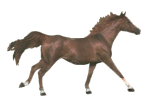
Scotland
915 Posts |
 Posted - 10 Apr 2012 : 3:29:12 PM Posted - 10 Apr 2012 : 3:29:12 PM





|
| Interesting thread,Stazi my chestnut gelding is getting more and more black spots,is this normal? |

www.blackislearabians.com
The greatness of a nation and its moral progress can be judged by the ways its animals are treated
|
Report to Moderator  |
|
|
Faracat
Silver Member
  
270 Posts |
|
|
Faracat
Silver Member
  
270 Posts |
|
|
Spangle
Bronze Member
 
210 Posts |
|
|
LIV
Gold Member
   

England
705 Posts |
 Posted - 10 Apr 2012 : 6:48:05 PM Posted - 10 Apr 2012 : 6:48:05 PM





|
Faracat, your picture of the bay with silver dapple is just like Phantom. He is bay but his black points are more grey than black and they gradually blend from bay to grey down his legs like your description. We've never really known what colour he is but this sounds more like it. It will be interesting to see if it disappears as he gets older.
|
     
|
Report to Moderator  |
|
|
garnet
Platinum Member
    

2382 Posts |
 Posted - 10 Apr 2012 : 6:51:33 PM Posted - 10 Apr 2012 : 6:51:33 PM





|
Was trying to remember the name 'birdcatcher spots' as a chestnut mare with lots of them recently arrived on our yard. Does anyone know why they have this name? I know the Bend Or ones are named for the racehorse - he is in Garnet's pedigree and she had some.
Red, the bay with beige legs, has a lot of white flecking in the wheel arches. Spangle, he is your girl's nephew - Vlacq Khazad/Vlacq Tathar. I remember Sue saying Shah was having a part Highland wife - would this be your girl's mum? |
  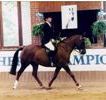 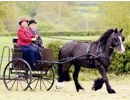 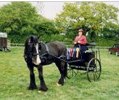 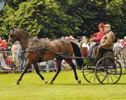 |
Report to Moderator  |
|
|
Callisto
Platinum Member
    

6905 Posts |
 Posted - 10 Apr 2012 : 6:56:35 PM Posted - 10 Apr 2012 : 6:56:35 PM





|
| Garnet, they were named for Birdcatcher, a celebrated racehorse in the early 19th Century. |
  Zahkira (GR Amaretto x Taffetta) Zahkira (GR Amaretto x Taffetta)
Linda
East Sussex |
Report to Moderator  |
|
|
Lanabanana
Platinum Member
    

United Kingdom
2691 Posts |
 Posted - 10 Apr 2012 : 7:45:03 PM Posted - 10 Apr 2012 : 7:45:03 PM





|
I actually agree with Keren, in that I don't think that white hairs in the mane of older horses is particularly uncommon.
I'd be interested to see Cinny's mane brushed onto one side, does it appear chestnut when 'laid'?
In the past when I've plaited horse for other people (PB's) I've often noticed lighter coloured hairs mixed in which aren't apparent when the mane is unplaited and laid on one side.
That's not to say I don't find it attractive by the way  |
     
Hampshire. |
Report to Moderator  |
|
|
Faracat
Silver Member
  
270 Posts |
 Posted - 10 Apr 2012 : 8:56:05 PM Posted - 10 Apr 2012 : 8:56:05 PM





|
Roaning (with no roan gene) around the 'wheelarches' (great term ;) ) is often due to Rabicano. There can be lots of roaning or just a small amount. This is a good example and shows the white hair at the top of the tail that rabicano also causes.

|
 |
Report to Moderator  |
|
|
Cinnypony
Gold Member
   
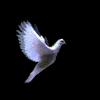
1160 Posts |
 Posted - 10 Apr 2012 : 9:09:52 PM Posted - 10 Apr 2012 : 9:09:52 PM






|
By the way Cinny was appalled at being called "older" as she only 12 
I will see if I can persuade her to have her mane tidy as it normally tumbles both sides.
The base of her mane at the withers is black and the tip of her tail is black with a little white skunky bit at the top. |
    
Cinnabar Moth --------------- -----------CF Matilda ----Red House Gaia
Susi
https://www.facebook.com/CinnabarEndurance/ |
Edited by - Cinnypony on 10 Apr 2012 9:13:43 PM |
Report to Moderator  |
|
|
Callisto
Platinum Member
    

6905 Posts |
 Posted - 10 Apr 2012 : 9:17:33 PM Posted - 10 Apr 2012 : 9:17:33 PM





|
Our chestnut had them (like Cinny's) from when we got him at 5 to when we lost him at 30, although there might have been a few more when he was 30, but not markedly so.
I think what Minhe said about them being the remnants of baby mane is interesting because that would explain why Harley's disappeared around the age of 5/6 - it was a clump of definite white halfway down his neck. The white in the middle of his tail is also a clump and is still there 17 years later. Does this make it a Gulastra plume? Sorry no photos of it to hand. |
  Zahkira (GR Amaretto x Taffetta) Zahkira (GR Amaretto x Taffetta)
Linda
East Sussex |
Edited by - Callisto on 10 Apr 2012 9:20:00 PM |
Report to Moderator  |
|
|
Spangle
Bronze Member
 
210 Posts |
|
|
shah
Gold Member
   
England
1356 Posts |
 Posted - 11 Apr 2012 : 07:47:13 AM Posted - 11 Apr 2012 : 07:47:13 AM





|
My lad is only 5 this year so his might be baby hairs then 
I will follow with interest to see if the whites multiply or disappear. But yes he has some spots on the coat too. |
West Sussex |
Report to Moderator  |
|
|
garnet
Platinum Member
    

2382 Posts |
 Posted - 12 Apr 2012 : 6:37:00 PM Posted - 12 Apr 2012 : 6:37:00 PM





|
Callisto, thanks for that. The name does ring a bell now you've said it (I spent many hours tracing Arab and TB pedigrees right back for Autumn and Garnet) but I didn't know he was spotty.
Spangle, are your Shah and Kaz children bred for endurance?
|
      |
Report to Moderator  |
|
|
susan p
Gold Member
   

Scotland
915 Posts |
 Posted - 13 Apr 2012 : 08:58:05 AM Posted - 13 Apr 2012 : 08:58:05 AM





|
| That's interesting does that mean that they are from an arabian stallion called Ben D'Or? |

www.blackislearabians.com
The greatness of a nation and its moral progress can be judged by the ways its animals are treated
|
Report to Moderator  |
|
|
Callisto
Platinum Member
    

6905 Posts |
 Posted - 13 Apr 2012 : 2:44:49 PM Posted - 13 Apr 2012 : 2:44:49 PM





|
Bend Or was a thoroughbred racehorse who won the 1880 Derby, apparently they (Bend Or spots) are most common in throughbreds but often appear in Arabians, particularly chestnuts, cause is unknown.
Birdcatcher spots (the white ones) can appear spontaneously and randomly at any place on the horse's body, they can appear at any time but seem to be most common in older horses. Sometimes they are permanent, and others can appear and disappear. Nobody knows what causes these either.
ETA Garnet I'm pretty certain that Spangle's horses were specifically bred for endurance. |
  Zahkira (GR Amaretto x Taffetta) Zahkira (GR Amaretto x Taffetta)
Linda
East Sussex |
Edited by - Callisto on 13 Apr 2012 2:56:28 PM |
Report to Moderator  |
|
|
susan p
Gold Member
   

Scotland
915 Posts |
 Posted - 13 Apr 2012 : 4:27:59 PM Posted - 13 Apr 2012 : 4:27:59 PM





|
| The arabian stallion Bend Or 1959 was also chestnut,I have been going back on all breeds to see if there is a connection,surely these spots are a genetic thing? |

www.blackislearabians.com
The greatness of a nation and its moral progress can be judged by the ways its animals are treated
|
Report to Moderator  |
|
|
Callisto
Platinum Member
    

6905 Posts |
 Posted - 13 Apr 2012 : 5:04:05 PM Posted - 13 Apr 2012 : 5:04:05 PM





|
It probably is a genetic thing:-
"Bend Or had white flecks on his chestnut coat, and like his damsire Thormanby, had black spots on his neck, shoulder, and on his quarters. These markings often showed up in his progeny and is referred to as Bend Or spotting"
He was also an ancestor of the Tetrarch (he was his dam's grandsire), another successful tb racehorse - a grey who was sprinkled with big white blotchy spots (known as Tetrarch spots) |
  Zahkira (GR Amaretto x Taffetta) Zahkira (GR Amaretto x Taffetta)
Linda
East Sussex |
Edited by - Callisto on 13 Apr 2012 5:06:08 PM |
Report to Moderator  |
|
|
garnet
Platinum Member
    

2382 Posts |
 Posted - 13 Apr 2012 : 6:25:59 PM Posted - 13 Apr 2012 : 6:25:59 PM





|
| Wasn't The Tetrarch known as The Spotted Wonder? |
      |
Report to Moderator  |
|
|
MinHe
Platinum Member
    
England
2927 Posts |
|
|
Cinnypony
Gold Member
   

1160 Posts |
|
 Topic Topic  |
|

